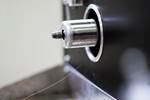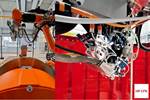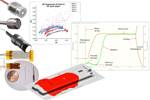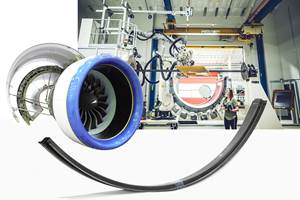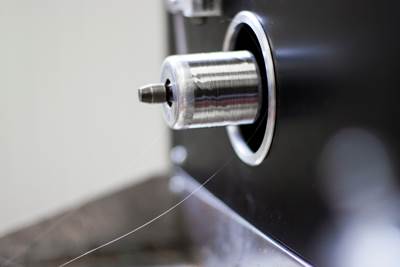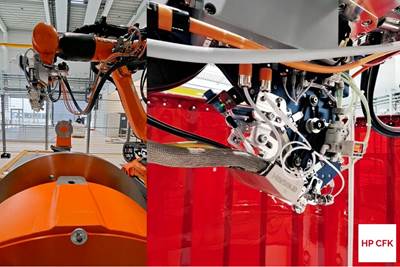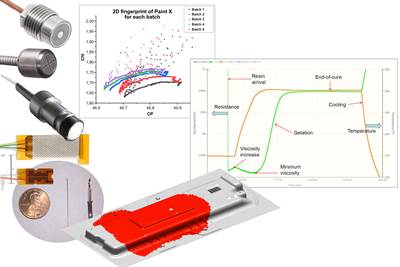Sensory consolidation roller for laser-based AFP enables innovative temperature measurement
Within the InSiTe project, IFW has demonstrated embedded fiber optic sensors for continuous measurement of temperature in the area of compaction with high spatial resolution up to 0.65 millimeter.
Source (All Images) | Institute of Production Engineering and Machine Tools (IFW)
As part of the , funded by the German Research Foundation (DFG), a strain-sensitive consolidation roller was developed and researched at the (IFW) at the University of Hannover. Used for the continuous measurement of process temperatures in laser-based automated fiber placement (LAFP), the sensitivity of the consolidation roller is achieved by glass fiber sensors that are embedded in the surface area. The detection of Rayleigh backscattering of laser light introduced into the glass fiber enables strain measurement with high spatial resolution. As part of the project, fundamental knowledge about the embedding of fiber optic sensors in the elastic material of the consolidation roller has been acquired and disturbance variables from the LAFP have also been identified and compensated for.
Using LAFP, it is possible to additively process high-performance carbon fiber-reinforced thermoplastic composite (CFRTP) tapes into lightweight, high-performance structures. This method offers in situ consolidation, where new plies of tape are heated with the laser and pressed together with those previously deposited using the consolidation roller. Compared to thermoset structures that are produced in an autoclave, such CFRTP structures offer the possibility of fusion bonding/welding methods to achieve dustless assembly (no drilling holes or fasteners) as well as improved recyclability. However, the challenge is to produce structures with equivalent mechanical properties. The quality of the end product depends in particular on the thermal-mechanical process control.
As part of the InSiTe project, it was shown that the thermal load, when joining the material layers, changes over the course of layup, partly due to the changing process boundary conditions of this additive manufacturing technique. For example, the increasing thickness of the laminate and the associated thermal insulation from the metal tool means that the laser power in the upper laminate layers can be significantly reduced compared to the lower layers. As a result, the layup speed, and thus productivity, can be increased. Continuous knowledge of the process temperatures and control of the process variables is therefore essential for consistent quality and efficient production, IFW says.
Currently available LAFP systems are equipped with a temperature control system that adjusts the laser power based on the temperature measured in front of the consolidation roller using infrared thermography. However, this radiation-based measuring method does not record any temperature information from the area under the consolidation roller, where the quality of the bonding of the material layers arises. The IFW has therefore designed a sensory consolidation roller with the aim of enabling the detection of temperatures in the area of the consolidation roller via a strain-sensitive surface area. For this purpose, a fiber optic sensor is applied to the consolidation roller. The measurement of Rayleigh backscattering of laser light irradiated into the optic fiber enables the analysis of its local strain state as well as correlation with the thermal load and also a high spatial resolution of the strain measurement points for up to 0.65 millimeter along the sensor.
Sensory consolidation roll for the laser-based thermoplastic AFP.
As part of the InSiTe project, the integration of the fiber optic sensor into the elastic coating of the consolidation roller and the resulting sensitivity of the surface area were initially investigated. As part of the investigation, the concept of gluing the optic fiber into a previously introduced groove on the lateral surface was pursued. For this purpose, different geometric parameters of the groove and different adhesive systems were varied. In experimental tests on simplified test specimens, it was found that embedding close to the surface with an elastic silicone adhesive leads to the highest strain sensitivity.
The knowledge gained from these tests was transferred to a prototype consolidation roller for use in the LAFP. Because there is both a thermal and a mechanical load in the LAFP that can influence the strain measurement, the next step was to develop a method for compensating for the disturbance variables and validate it in process tests. At the same time, a thermodynamic model of the LAFP was developed, which is used to calibrate the sensor. The model provides temperature values that are intended for correlation with the measured and compensated strain values.
To conclude the project and for the final evaluation of the sensor system, a validation study will be carried out in the next few weeks under real operating conditions during the production of a flat laminate at the LAFP.
Read more “” or contact Maximilian Kaczemirzk at kaczemirzk@ifw.uni-hannover.de.
Related Content
The potential for thermoplastic composite nacelles
Collins Aerospace draws on global team, decades of experience to demonstrate large, curved AFP and welded structures for the next generation of aircraft.
Read MoreASCEND program completion: Transforming the U.K.'s high-rate composites manufacturing capability
GKN Aerospace, McLaren Automotive and U.K. partners chart the final chapter of the 4-year, £39.6 million ASCEND program, which accomplished significant progress in high-rate production, Industry 4.0 and sustainable composites manufacturing.
Read MoreAirbus video highlights RACER compound helicopter first flight
Launched as part of a Clean Sky 2 program, a compound design — rotor, split fixed-wing, propulsive propellers — uses composites to cut fuel consumption and emissions by 20%.
Read MorePlant tour: Aernnova Composites, Toledo and Illescas, Spain
RTM and ATL/AFP high-rate production sites feature this composites and engineering leader’s continued push for excellence and innovation for future airframes.
Read MoreRead Next
Contact-less microsensor targets real-time NDT for composite structures
RVmagnetics’ MicroWire self-monitors composite structures via embedding during the production process. It improves safety, control and real-time data for predictive maintenance.
Read MoreIFW’s AFP installation enhances thermoplastic structure production
Commissioned AddComposites AFP manufacturing cells with humm3 flashlamps are located at IFW’s Stade and Garbsen facilities to expand R&D services.
Read MoreSensors: Data for next-gen composites manufacturing
In the quest for sustainability, sensors are reducing cycle times, energy use and waste, automating closed-loop process control and increasing knowledge to open new possibilities for intelligent manufacturing and structures.
Read More
